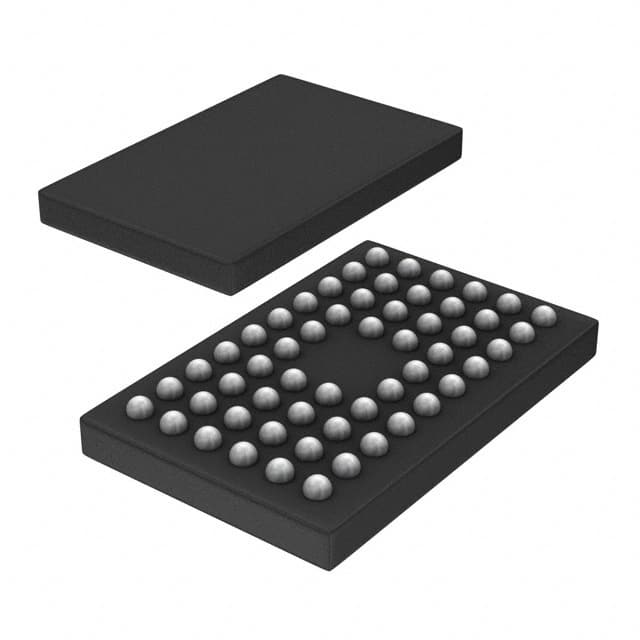SSTVF16857EV,518
Basic Information Overview
- Category: Integrated Circuit (IC)
- Use: Signal Switching and Voltage Level Shifting
- Characteristics: High-speed switching, low power consumption
- Package: 48-pin TSSOP (Thin Shrink Small Outline Package)
- Essence: This IC is designed to provide signal switching and voltage level shifting capabilities in electronic circuits.
- Packaging/Quantity: Available in reels of 2500 units
Specifications
- Supply Voltage Range: 1.65V to 3.6V
- Input Voltage Range: 0V to VCC
- Output Voltage Range: 0V to VCC
- Operating Temperature Range: -40°C to +85°C
- Maximum Input Current: ±10mA
- Maximum Output Current: ±32mA
- Propagation Delay Time: 2.5ns (typical)
Detailed Pin Configuration
The SSTVF16857EV,518 IC has a total of 48 pins. The pin configuration is as follows:
- OE (Output Enable) 1
- I/O0 (Bidirectional Data I/O) 1
- GND (Ground)
- I/O1 (Bidirectional Data I/O) 1
- VCC (Supply Voltage)
- I/O2 (Bidirectional Data I/O) 1
- I/O3 (Bidirectional Data I/O) 1
- I/O4 (Bidirectional Data I/O) 1
- I/O5 (Bidirectional Data I/O) 1
- I/O6 (Bidirectional Data I/O) 1
- I/O7 (Bidirectional Data I/O) 1
- I/O8 (Bidirectional Data I/O) 1
- I/O9 (Bidirectional Data I/O) 1
- I/O10 (Bidirectional Data I/O) 1
- I/O11 (Bidirectional Data I/O) 1
- VCC (Supply Voltage)
- GND (Ground)
- I/O12 (Bidirectional Data I/O) 1
- I/O13 (Bidirectional Data I/O) 1
- I/O14 (Bidirectional Data I/O) 1
- I/O15 (Bidirectional Data I/O) 1
- I/O16 (Bidirectional Data I/O) 1
- I/O17 (Bidirectional Data I/O) 1
- I/O18 (Bidirectional Data I/O) 1
- I/O19 (Bidirectional Data I/O) 1
- I/O20 (Bidirectional Data I/O) 1
- I/O21 (Bidirectional Data I/O) 1
- I/O22 (Bidirectional Data I/O) 1
- I/O23 (Bidirectional Data I/O) 1
- VCC (Supply Voltage)
- GND (Ground)
- I/O24 (Bidirectional Data I/O) 1
- I/O25 (Bidirectional Data I/O) 1
- I/O26 (Bidirectional Data I/O) 1
- I/O27 (Bidirectional Data I/O) 1
- I/O28 (Bidirectional Data I/O) 1
- I/O29 (Bidirectional Data I/O) 1
- I/O30 (Bidirectional Data I/O) 1
- I/O31 (Bidirectional Data I/O) 1
- I/O32 (Bidirectional Data I/O) 1
- I/O33 (Bidirectional Data I/O) 1
- I/O34 (Bidirectional Data I/O) 1
- I/O35 (Bidirectional Data I/O) 1
- VCC (Supply Voltage)
- GND (Ground)
- I/O36 (Bidirectional Data I/O) 1
- I/O37 (Bidirectional Data I/O) 1
- OE (Output Enable) 2
Functional Features
- Bidirectional signal switching between two voltage domains
- Level shifting capability for interfacing different logic families
- High-speed operation suitable for data transmission applications
- Low power consumption for energy-efficient designs
- Output enable control for flexible signal routing
Advantages and Disadvantages
Advantages: - Provides efficient signal switching and voltage level shifting capabilities - High-speed operation allows for fast data transmission - Low power consumption helps in reducing energy usage - Flexible output enable control enhances signal routing options
Disadvantages: - Limited number of bidirectional data I/O pins (38 in total) - Requires careful consideration of voltage compatibility with connected devices
10個與SSTVF16857EV,518在技術方案中應用相關的常見問題與解答
Sure! Here are 10 common questions and answers related to the application of SSTVF16857EV,518 in technical solutions:
Q: What is SSTVF16857EV,518? A: SSTVF16857EV,518 is a specific model or part number of a technical solution, typically used in electronic systems.
Q: What are the key features of SSTVF16857EV,518? A: The key features of SSTVF16857EV,518 may include high-speed data transfer, low power consumption, compact size, and compatibility with certain protocols.
Q: In which applications can SSTVF16857EV,518 be used? A: SSTVF16857EV,518 can be used in various applications such as telecommunications, networking, data storage, and industrial automation.
Q: What is the maximum data transfer rate supported by SSTVF16857EV,518? A: The maximum data transfer rate supported by SSTVF16857EV,518 is typically mentioned in the product specifications and can vary depending on the implementation.
Q: Is SSTVF16857EV,518 compatible with different operating systems? A: SSTVF16857EV,518 is designed to be compatible with various operating systems, but it's always recommended to check the product documentation for specific details.
Q: Can SSTVF16857EV,518 be used in both wired and wireless applications? A: SSTVF16857EV,518 is primarily designed for wired applications, but it can be integrated into wireless systems through appropriate interfaces or adapters.
Q: What are the power requirements for SSTVF16857EV,518? A: The power requirements for SSTVF16857EV,518 are typically specified in the product datasheet and may include voltage range, current consumption, and any additional power considerations.
Q: Are there any specific programming requirements for SSTVF16857EV,518? A: SSTVF16857EV,518 may require specific programming or configuration depending on the application. It's important to refer to the product documentation or technical support for guidance.
Q: Can SSTVF16857EV,518 be used in harsh environmental conditions? A: SSTVF16857EV,518 may have certain environmental specifications such as operating temperature range, humidity tolerance, and resistance to vibration or shock. These should be considered when deploying it in harsh conditions.
Q: Where can I find technical support or documentation for SSTVF16857EV,518? A: Technical support and documentation for SSTVF16857EV,518 can usually be found on the manufacturer's website or by contacting their customer support directly.


